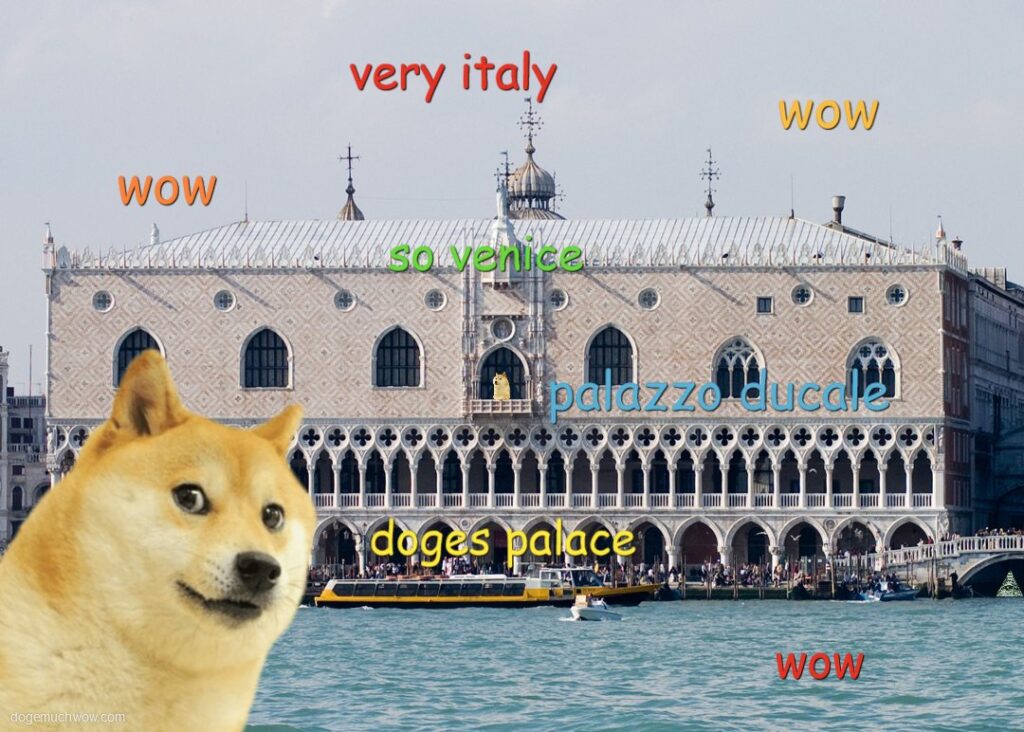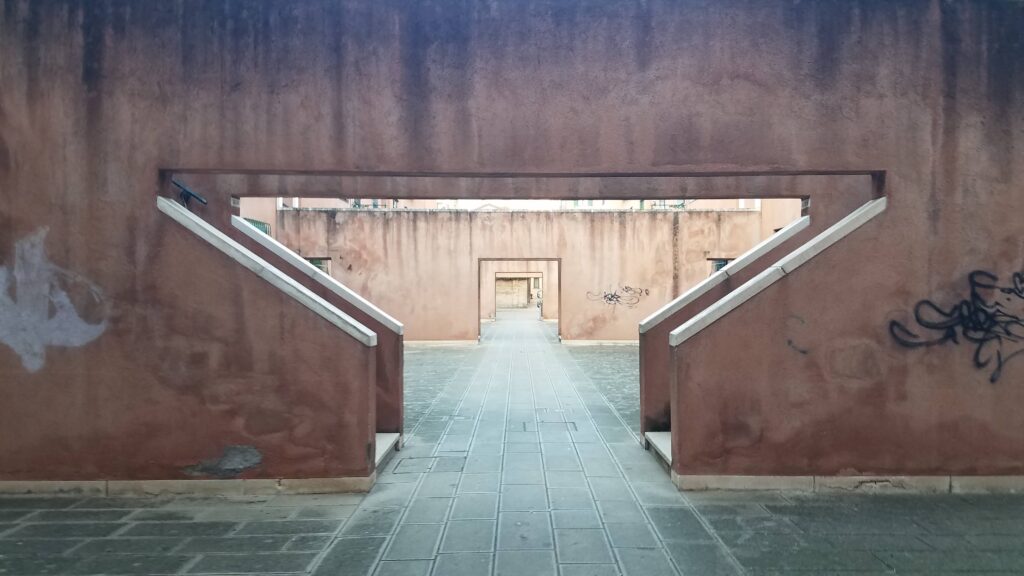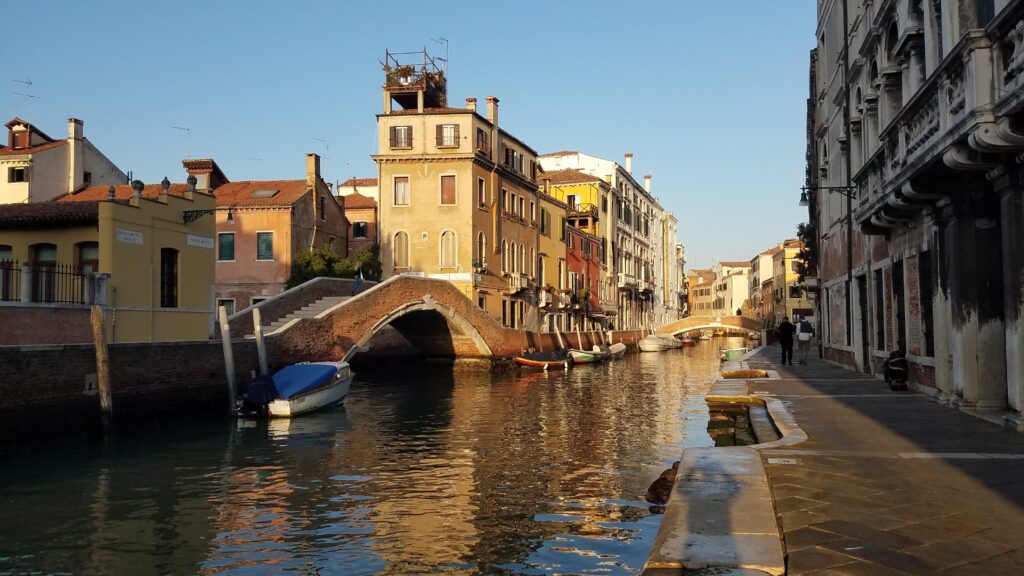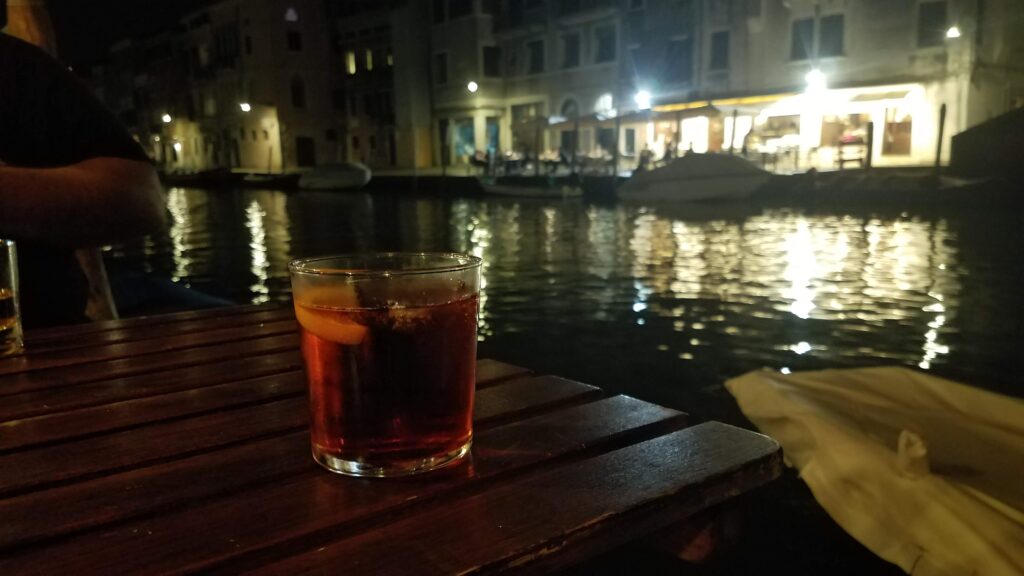Paolo, the gondolier: Where are you from?
Me, proudly: United States. Pittsburgh – City of Bridges.
Paolo: Oh, we have 395 bridges here.
Christian, whispering fervently in my ear: Don’t say it. Don’t say it. Don’t say it.
Last October we found ourselves in one of the most popular tourist cities in the world: Venice. It’s a place well worthy of tourism, being jam-packed with rich history, culture, and cuisine, but we almost didn’t go because it is such a notorious day-trip destination. Indeed, Christian and I tend to prefer vacation experiences that are off the beaten path, but the gaggles of tourists that flock through Venice, most only staying for a few hours, are more than an annoyance to locals – that type of tourism causes legitimate damage to the city… structurally, ecologically, and financially.
Venice is dependent upon tourism, certainly, but the questions I weighed in my mind when planning our trip were 1) whether it was possible to support local businesses in a more thoughtful, sustainable way (and, if so, how), and 2) whether we could even justify traveling there and supporting any part of the tourist industry knowing that simply going there, no matter how responsibly, would put the city in further danger. It should be no surprise that the first question was much easier to answer… and you already know the answer to the second one.
Winning the Title
Venice is located in a lagoon in Northeast Italy, on the Adriatic Sea, and is made up of over 100 small islands connected by bridges. The historic center (centro storico) is what most people think of when it comes to Venice, but there are many more islands of varying size throughout the lagoon and sections of the mainland itself that fall within the city’s borders. The islands of the centro storico were themselves manmade, created by driving tree trunks into the muddy lagoon floor and setting plates of limestone on top of the piles to create foundations for everything that seems to rise out of the water – a really impressive feat for an area of about two square miles. Consequently, anything other than foot traffic in the city must be by boat – we didn’t even see any bicycles, which would not be very feasible with all the steps up and down at most of the bridges.

Image credit: [1]
It was the quantity of those bridges that has created a friendly rivalry between the cities of Venice and Pittsburgh, each nicknamed “City of Bridges.” From what I could tell while we were there, the rivalry is pretty one-sided, but, for the record, Pittsburgh has more. Amusingly, even the simple act of making that statement on Facebook launched an argument with a friend who was not even Italian, but American! Participating in this argument took far more time and emotional energy than I wanted to spend on a vacation where I had intended to be mentally present, in the moment, and disconnected from social media to the greatest extent possible. But there was an argument on the internet, and I had to be right.
As it happens, there are many different counts regarding the number of bridges in each city, depending largely on what counts as a bridge. Venetian bridges are a little more uniform: although they are made of stone, metal, or wood, (almost?) all of them are pedestrian paths over water. Even so, counts I’ve seen range from 300,[2] to 391,[3] to 435 (the most commonly accepted number).[4] Meanwhile in Pittsburgh, we’ve got highways over rivers, elevated roadways, pedestrian walkways, rail bridges, and more, representing anything from 28, to 297, to 446 (the most commonly accepted number), to 700 [5] – now back up to full counts since the reopening of the Fern Hollow Bridge last month![6]
What was truly surprising when I was searching for the “true” number was the sheer persistence of misinformation on the internet (I know – it’s shocking), specifically the belief that the winner of the Venice / Pittsburgh rivalry boasts the most bridges in the world. Despite a common misconception clung to by many (including the president of the United States), we have nowhere near the most bridges in the world – we don’t even have the most in Pennsylvania! The idea that Pittsburgh or Venice leads the world in bridges is patently false, and not something that was ever in question (at least not for me). All that matters is that we have more than Venice, which we do.
That Sinking Feeling
But I didn’t travel to Venice to gloat about Pittsburgh’s extensive but crumbling infrastructure – there was enough of that at our destination, and Pittsburgh isn’t a UNESCO World Heritage Site.[7] Venice, aside from being stunningly beautiful in its own right, has been home to countless artists over its 1,600-year history and served as a major center of commerce from the 13th to 17th centuries. Today, tourism is Venice’s primary source of revenue, bringing in around €1.5B per year.[8] That revenue isn’t without cost, though, when we consider the overabundance of tourists, the flight of residents, and the slow but sure descent of the city below the water level.

First the tourists: according to Euromonitor, Venice received about 5.5 million visitors in 2018, placing it at 46th place on the list of world’s most touristy cities.[9] However, their definition of “visit” includes a minimum stay of 24 hours, which may represent 20% or less of Venice’s tourist headcount. Day-trippers in 2019 were counted in the ballpark of 19 million, many of whom depart their cruise ships and flood the city for only a few hours, having very little interaction with the city beyond taking selfies in St. Mark’s Square and patronizing cheap souvenir shops.[10]
The consequences of increased day-tourism include increased strain on existing infrastructure (not just the buildings and walkways themselves, but supply chains and waste management, which are already challenged to start with in a city of waterways instead of roads) as well as the fabric of society. If we spread out the day-trippers across the year (which isn’t what actually happens), Venice would still see at least one tourist for every resident every day – in reality, that number can be double in peak season. The glut of tourists along the Grand Canal means that restaurants, shops, and hotels off the beaten path get less attention and have more difficulty staying open. Employment outside of tourism is becoming more difficult to find, an already high cost of living is still rising, and the sense of community erodes with every departing resident. The actual population of the city (approximately 175,000 in the middle of the 20th century) had dropped to around 50,000 by the fall of 2021.[11]
Quality Over Quantity
It should be unsurprising to hear that the more quality time tourists spend in the city, the more the city is likely to benefit – at least financially. Visitors who stay at least one night make up only 14% of tourists, according to a NYT article, but they represent almost half of the city’s tourism revenue. Meanwhile, the average cruise passenger is responsible for about €200 toward Venice’s economy, but the benefits of those Euro are largely indirect, in the form of taxes and refueling, rather than directly supporting restaurants, museums, and local artisans.[12] There is an argument to be made that as long as Venice has tourists, their demand for services will drive some level of employment for the tourism industry, but the industry itself is putting the city at physical risk.
The biggest target of Venetian ire is the cruise industry. There are plenty of things to be said about the massive ecological impacts of cruise ships [13] (enough to create a designated blog post), and the ones that travel to Venice cause erosion of the lagoon and add pollution to water and air alike. Cruise ships are technically banned from Venice, but only if they have an alternate route to access the harbor on the mainland, which they currently do not. Unfortunately, the major route for large ships – with a trench dug deep enough to allow passage – goes right through part of the city in the Giudecca Canal. With the rest of the lagoon far too shallow, (five feet deep in some places), large ships cannot be easily rerouted.[14]

In addition to the erosion risks from large ships, Venice has itself been sinking basically since it was created thanks to the not-entirely-solid lagoon floor on which it was built and – more recently – the draining of the aquifer on which the lagoon sits (for industrial purposes). While the current subsidence rate of 1-2 mm per year may seem small, St. Mark’s Square is only 64 cm (25 inches) above sea level,[15] and sea levels are rising. And it is always worth a reminder that the fossil fuels burned to get cruise ships and airplanes to Italy incrementally add to climate change – and consequently sea level rise – with each trip.
So what can be done?
There have been a number of solutions posed over the years, including strictly limiting the number of visitors in the city at a given time [16] or officially banning cruise ships altogether (not just on paper). While the city is not going to such extremes yet, the day after this post goes live Venice will begin enacting a day-tripper fee for tourists who don’t stay overnight. The fee is nominal (about €3-10, based on surge pricing), but the fines for people who try to skirt it will be hefty (about €300).[17] There is hope that even a nominal fee will raise awareness of how much the city is at risk and support more mindful tourism, if not offset some of the costs of supporting that tourism.
There is certainly the argument that travel, even responsible travel, is harmful to the environment in pretty much any form, and that was certainly on my mind. However, we were going to be in Italy anyway, and the carbon footprint of our flight would contribute to climate change whether we drove up to Venice or not. It was actually an article on sustainable tourism in Venice that helped me make up my mind that I wanted to do it if we could do it right. And doing it right includes going off-season (we were there in late October), avoiding the major tourist areas (we did one or two tourist things but mostly kept off the beaten path), and staying one or more nights (when the city really is at its best without the press of day-trippers).[18]
It was during our non-touristy stay that we enjoyed things that many day-trippers wouldn’t have access to in a whirlwind visit. We toured a gorgeous but sparsely-attended church, checked out a gondola repair shop, and listened to a performance of the “Four Seasons,” by hometown hero Antonio Vivaldi. Over the course of several leisurely meals, I had the best caprese salad of my life, the best panna cotta of my life, and was introduced to what is now one of my favorite cocktails. And while there were so many things that fascinated me about Venice (resulting in an extra-long post that barely began to cover our experience there) I still wanted to shoe-horn an Italian recipe in here if I could, so here we go…

Recipe: The Classic Negroni
I had heard of this Italian aperitivo before but didn’t know what was in it and had never tasted one until our second (and last) night in Venice. Sitting at a table along a canal, with a little bit of a chill in the air for the first time on the trip, listening to music waft out from a jazz club, watching lights play on the water as taxis motored by, and savoring each sip of this deliciously bitter drink is one of my favorite memories from Italy. It was utter magic, and I can’t mix one for myself at home without being transported back to that moment.
Stir with ice (don’t shake):
- 1oz Campari
- 1oz Gin (I use Bombay Sapphire)
- 1oz Sweet vermouth (I use Carpano Antica)
Strain into a rocks glass, over a large ice cube
Garnish with orange peel
Given how old this drink is (widely accepted to have origins in 1919 in Florence) and how simple, it has spawned a great many variants.[19] But even sticking to the recipe as written can result in a range of different end products. Campari is what it is, but gin and sweet vermouth both vary greatly by the brand. Online cocktail sites I’ve referenced suggest trying different combinations until you find something you like. Unfortunately, I didn’t think to ask what was mixed into my very first (and very best) negroni on that night in Venice. I suppose I’ll have to go back… someday.
~
Have you been to Venice? How long were you there, what did you do, and did you feel it was enough time? I’d love to hear about it below.
Thanks for reading!
[1] https://dogemuchwow.com/doges-palace-in-venice/
[2] https://citywonders.com/blog/Italy/Venice/6-unmissable-bridges-in-venice
[3] https://www.veniceinsiderguide.com/how-many-bridges-are-in-venice/
[4] https://en.wikipedia.org/wiki/List_of_bridges_in_Venice
[5] https://www.pittsburghmagazine.com/does-pittsburgh-really-have-more-bridges-than-any-other-city/
[6] https://en.wikipedia.org/wiki/Fern_Hollow_Bridge
[7] https://whc.unesco.org/en/list/394
[9] https://en.wikipedia.org/wiki/List_of_cities_by_international_visitors
[10] https://www.npr.org/2022/07/03/1109615164/italy-venice-travel-new-rules
[11] https://allaboutvenice.com/venice-population/
[12] https://www.nytimes.com/2021/07/08/travel/venice-cruise-ships-environment.html
[13] https://youtu.be/zV01-5fRUtg?t=67
[14] https://www.nytimes.com/2021/07/08/travel/venice-cruise-ships-environment.html
[15] https://en.wikipedia.org/wiki/Venice
[16] https://digital.wpi.edu/downloads/05741s34c
[17] https://www.npr.org/2022/07/03/1109615164/italy-venice-travel-new-rules
[18] https://www.responsiblevacation.com/copy/overtourism-in-venice
[19] https://www.liquor.com/recipes/negroni/
2 Comments
Robert Smith · January 15, 2023 at 10:55 am
Thank you so much for this article! It was really an interesting read. Kathy and I visited Venice in October 2018 (it was the first stop for our 25th anniversary vacation, which was a Meditteranean cruise – our cruise line was Holland America and our ship had a capacity of just under 2000 guests). We arrived on a Saturday and two nights before we separted on our cruise.
I definitely agree with you that getting to visit some of the non-touristy portions of cities (not just Venice) but any city is well wirth the while. We did visit some of the touristy spots, like the Doge’s Palace and St. Mark’s Square, be we also did some walks about and found some smaller museums, some specialty ones such as the Music Museum (https://www.museodellamusica.com/). Our hotel also made some nice recommendations for restaurants off the beaten track. It was great to wander, with only the maps on our phone to figure out how to get back.
One of the side effects of the pandemic has been the reduction in our personal travel (not just because of the pandemic, but overall). For our last two visit to family in Arizona we drove instead of flying (we own electric vehicles). And I guess that this is getting a bit off track from Venice, but the pandemic pause has really helped to emphasize to me the importance of traveling responsibly and it is great to hear that others, like you, are also think about and are doing this, too!
And, yes, Pittsburgh has more bridges than Venice. 🙂
Alison · February 11, 2023 at 8:52 am
I’m so glad you enjoyed the article – and that you got off the beaten path in Venice. The city has so much more to offer than what’s on the standard tourist checklist… though I guess that could be said of most places.